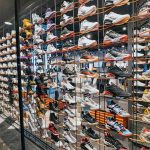Saucony looks like it is solidly back on the road to recovery after posting its second straight year of positive sales growth. SCNY has certainly turned things around from a rough 2001 when the company posted a loss of $900,000 after sales fell 21% for that year. While sales havent made it back to the level the company had in 2000 when it posted sales of nearly $168 million, SCNY posted profits this year that approach the levels of that period on sales that are roughly 20% lower.
If the sales engine kicks in this year — and a 15% backlog at year-end appears to put them in the running again for nice growth — results for 2004 may just break some records for SCNY as they drive toward their goal of doubling the business within the next five years.
Net sales for Q4 increased 8.3% to $30.5 million from $28.2 million in the fourth quarter of 2002 and up 41% from Q4 2001. Domestic net sales in Q4 2003 increased 11.5% to $24.3 million compared to $21.8 million in Q4 2002. The International business dipped 3.1% in Q4 to $6.2 million from $6.4 million in the year-ago period, due primarily to “economic conditions in Pacific rim countries”. Saucony brand business increased 2.0% to $5.9 million, due primarily from the weaker dollar.
Saucony brand footwear accounted for approximately 84% of total Q4 sales, with domestic sales increasing 18% to $19.6 million. Hind apparel and factory outlet stores domestic sales decreased 8.0% to $4.8 million, due to declining Hind sales, offset in part by increase factory store sales.
Net income for Q4 increased 83% to $1.5 million, compared to $806,000 in the fourth quarter of 2002. The Class A share EPS increase was 75% to 21 cents per diluted share while the Class B share EPS increase was 84.6% to 24 cents per share.
Net income was impacted by the sale of the companys Bangor, ME manufacturing operation in November 2003 and a settlement agreement from the liquidation of assets of a former customer, offset by charges associated with the vesting of stock options issued to five footwear suppliers in March 2001. Net pre-tax upside for the year was roughly $804,000.
Gross margin in the quarter improved by 190 basis points to 35.5% compared to 33.6% in Q4 2002.
For the year, Saucony brand sales were down 2.0% to $81.7 million, due primarily to lower average selling prices and decreased close-out unit volumes. The company pointed to a greater proportion of sales going to the lower priced “cross-over” segment as the driver for lower ASPs. Cross-over products, which have key price point products at $60 to $75, were approximately 30% of total domestic backlog and 27% of total domestic sales in Q4.
The ratio of technical product to Originals product sold stood at 85% technical, 15% Originals for both Q4 and the year, nearly “identical” to 2002.
Other domestic business for the year increased 8.4% to $21.9 million, due primarily to increased outlet store sales and to a lesser extent, an increase in Hind sales. The company now has 17 outlet stores versus 12 at year-end 2002.
Saucony brand International sales increased 12.3% to $31 million, again primarily due to the weaker dollar.
Backlog for orders to be shipped in the next five months is up 16% on top of a 14% increase posted last year at year-end.
The company will try to avoid a replay of last year when the 12 month backlog at the end of the year was up 23%, but heavy cancels impacted both Spring fill-in and Fall futures, resulting in a sales gain of just 2.2% for the year. The company will increase its advertising by $2.5 million in 2004, with 55% to 60% of the total spend going against mall-based specialty business.
“Success at this channel in this area translates to both strategic door expansion as well as capturing and then keeping a younger target consumer,” said company chairman and CEO John Fisher. “It is undeniably a key channel in our strategic goal to drive top-line in '04 and then beyond,” he said.
Fisher said the company tested the marketing program during “the latter half of fiscal year '03” through a smaller “targeted spend program” with two key mall partners and saw “product sell-through rates increase” along with an improvement in “brand buzz”.
SCNY expects first quarter net sales to range from $43 million to $44 million and delivering diluted earnings per share 44 cents to 46 cents range for Class A shares and 48 cents to 50 cents for Class B shares.
Full year diluted EPS is seen $1.29 to $1.32 for Class A shares and $1.42 to $1.46 for Class B shares on sales in the $155 million to $157 million range for the year.















